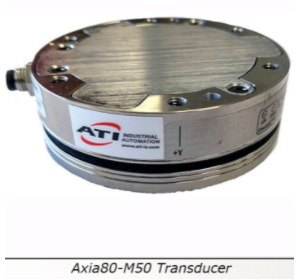|
E-Motion Newsletter - October 2021 ATI force/torque Sensors Company News - October 2021
E-Motion would
like to let our customers have a great selection of
ATI sensors.

What is a Six-Axis Force/Torque
Transducer?
What is
included in a complete F/T System?
A
complete F/T system consists of a calibrated sensor/transducer and a system
interface.
Model
selection is based on:
How do I Choose the Correct
Calibration for My Sensor Model?
To choose the correct
calibration, consider the worst-case moment load that will be applied to the
sensor. Typically, the moment capacity is the determining factor when choosing
the correct sensor model and calibration range. In robotic applications, the worst-case
moment load is typically a dynamic load caused by the acceleration of the
robotic end effector. For this reason, you will have to consider the
speed/power setting of the robot, as the speed/power setting normally
determines the maximum acceleration. The loading case below can be used as a worst-case
load assumption.

Like all of ATI’s
Force/Torque Sensors, the Axia80 measures all six components of force and
torque. The Axia80 is programmed with two different calibrations; the default
calibration allows for a large sensing range during high-speed moves or while
applying high force. The smaller calibration suits more delicate processes that
require higher resolution and accuracy.
All the electronics are built
into the transducer body, and the sensor connects directly to the robot
controller. This keeps the unit’s cost down and footprint smaller, without
sacrificing accuracy, resolution, or robustness. The Axia80 communicates
through EtherCAT, Ethernet, or Serial/USB and is ideal for robotic assembly, grinding,
and polishing applications.
To support a broad range of
applications, the Axia80 Force/Torque Sensor is available in three different
load ranges. The M8, M20, and M50 models have the same compact and lightweight
dimensions and are named for their maximum torque ranges of 8Nm, 20Nm, and 50Nm
respectively.

|




